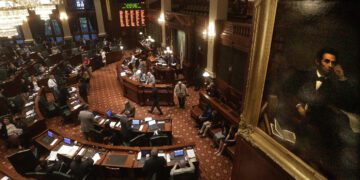Bye bye, spending caps. John Merline writes:
Three days after President Trump told his aides to look for deep cuts in federal spending for 2020, he agreed to a budget deal that blows a $320 billion hole in the spending caps and allows a two-year suspension of the debt ceiling. […]
The 2011 budget caps, remember, were part of the Republicans’ deal with President Obama, which they secured in exchange for letting some of President Bush’s tax cuts expire. To give the caps teeth, the deal included a sequester provision that imposed automatic, across-the-board spending cuts if Congress couldn’t figure out how to live within its means.
For a time, those spending caps actually worked.
Overall, federal outlays declined for three years straight after that agreement, when you adjust for inflation. As a share of GDP, spending shrank from 23.4% down to 20.2%. Lo and behold, the world didn’t come to an end.
Since then, however, Congress lost interest in spending restraint, and the floodgates reopened. Despite the technical existence of spending caps, outlays have shot up 19% in real terms since 2014. Spending is up nearly 9% in just the past two years alone. As a share of GDP, federal expenditures have crept back up to 21.3%.
To understand what this means for the deficit, consider that if Congress had simply held spending growth to the rate of inflation after 2014, the deficit this year would be $400 billion, instead of more than $1 trillion. […]
The Congressional Budget Office now estimates that, unless Congress and the White House come to grips with spending, projected deficits over the next three decades will “drive federal debt held by the public to unprecedented levels — from 78% of gross domestic product in 2019 to 144% by 2049.” Interest payments alone will start to swamp the budget, making it all the harder to ever get to a balanced budget.
It’s important to note that this problem is not being driven by Trump’s tax cuts. Even with those cuts in place, federal revenues are near the postwar average, and they are slated to continue to claim a larger share of GDP each year for the next several decades.
[John Merline, “A Budget Disaster of Epic Proportions,” Issues & Insights, July 22]







